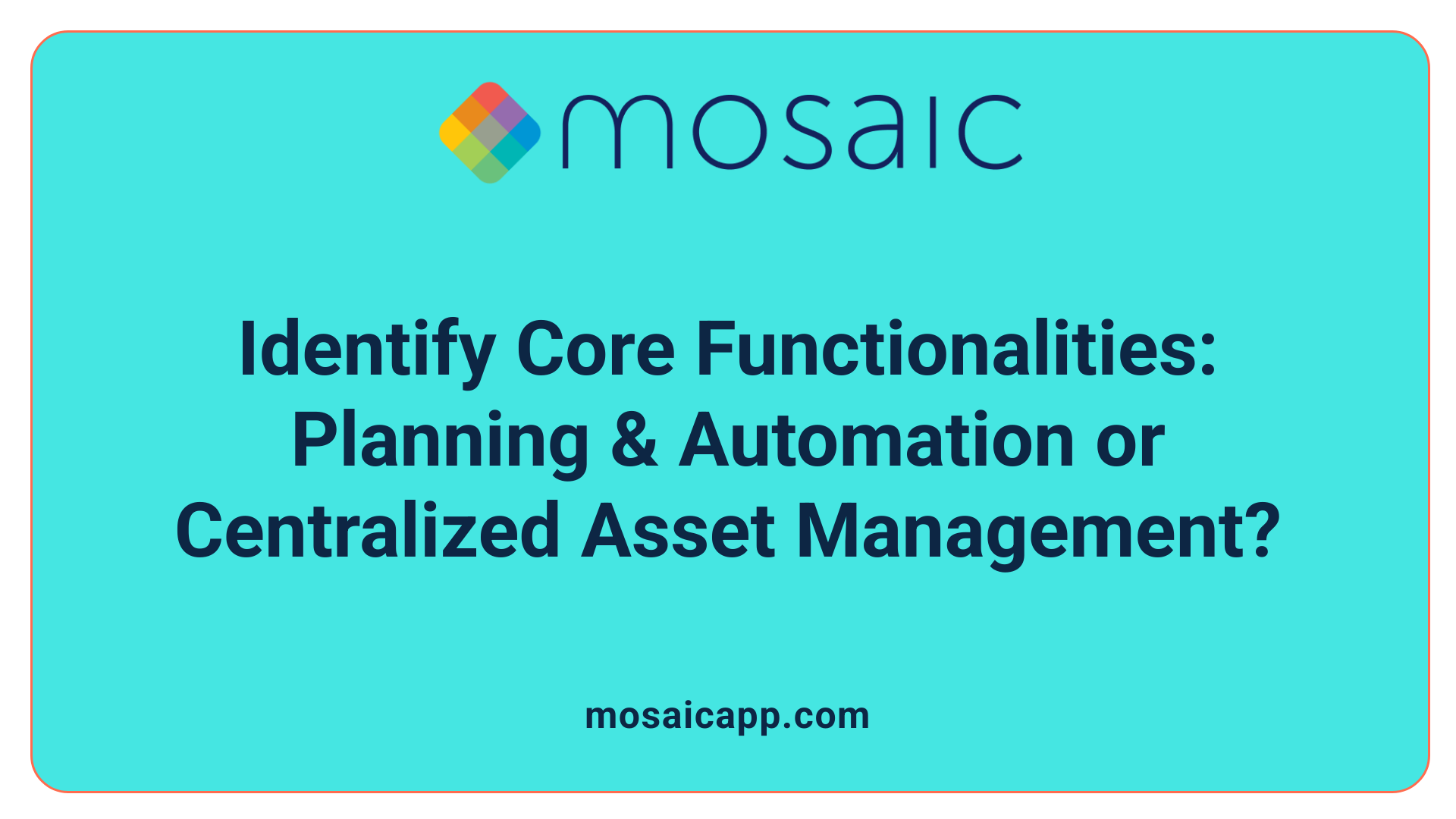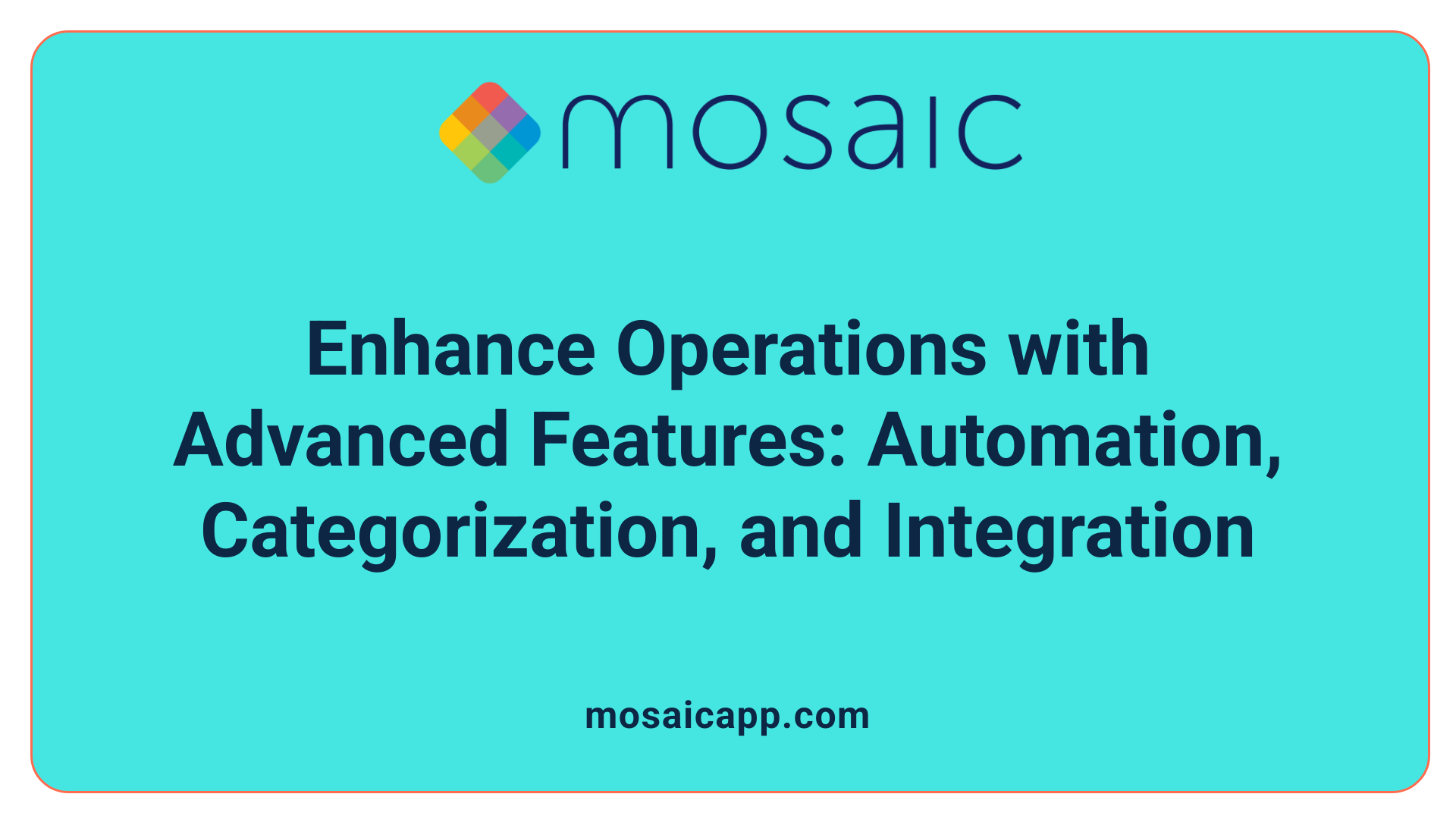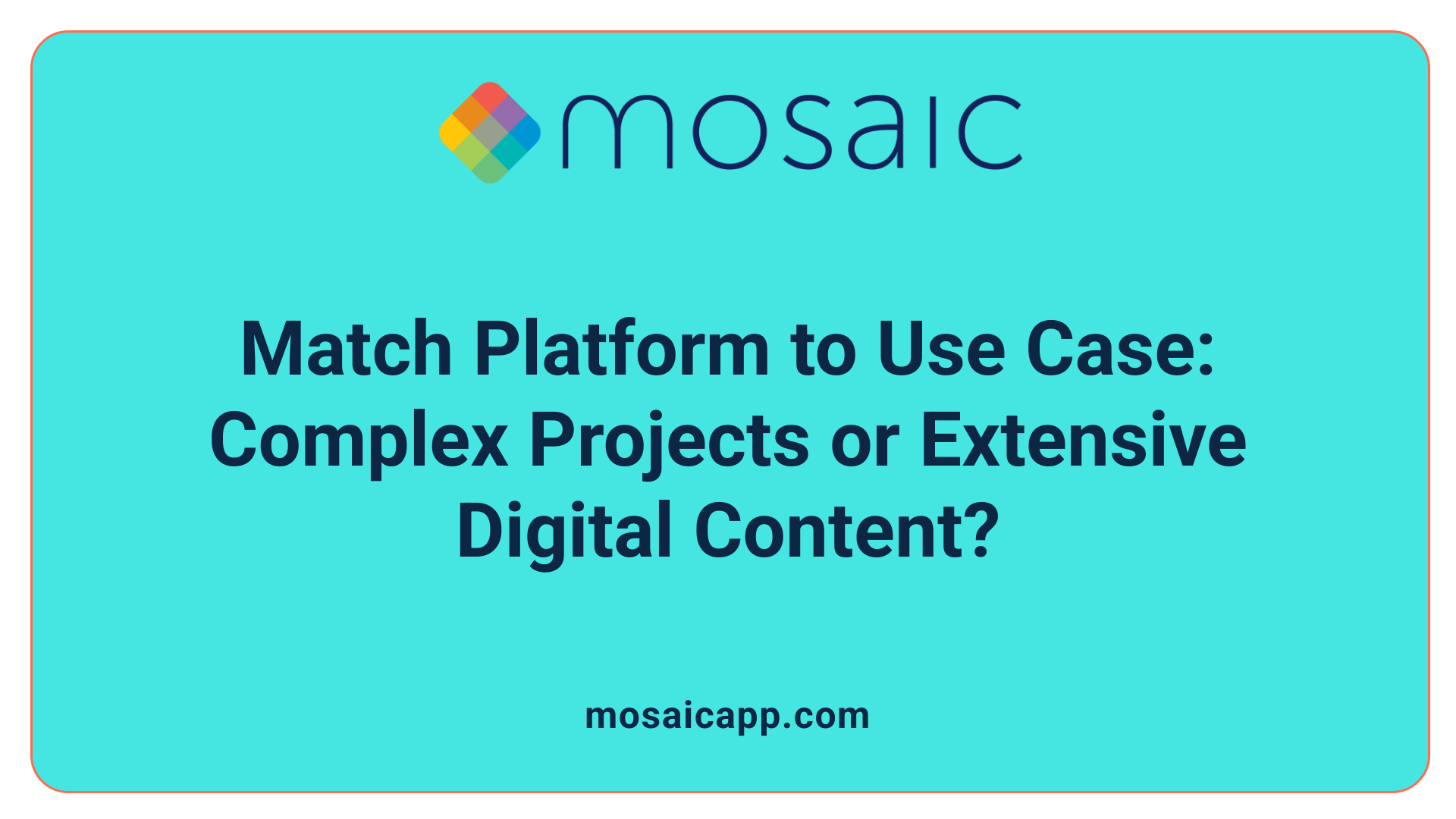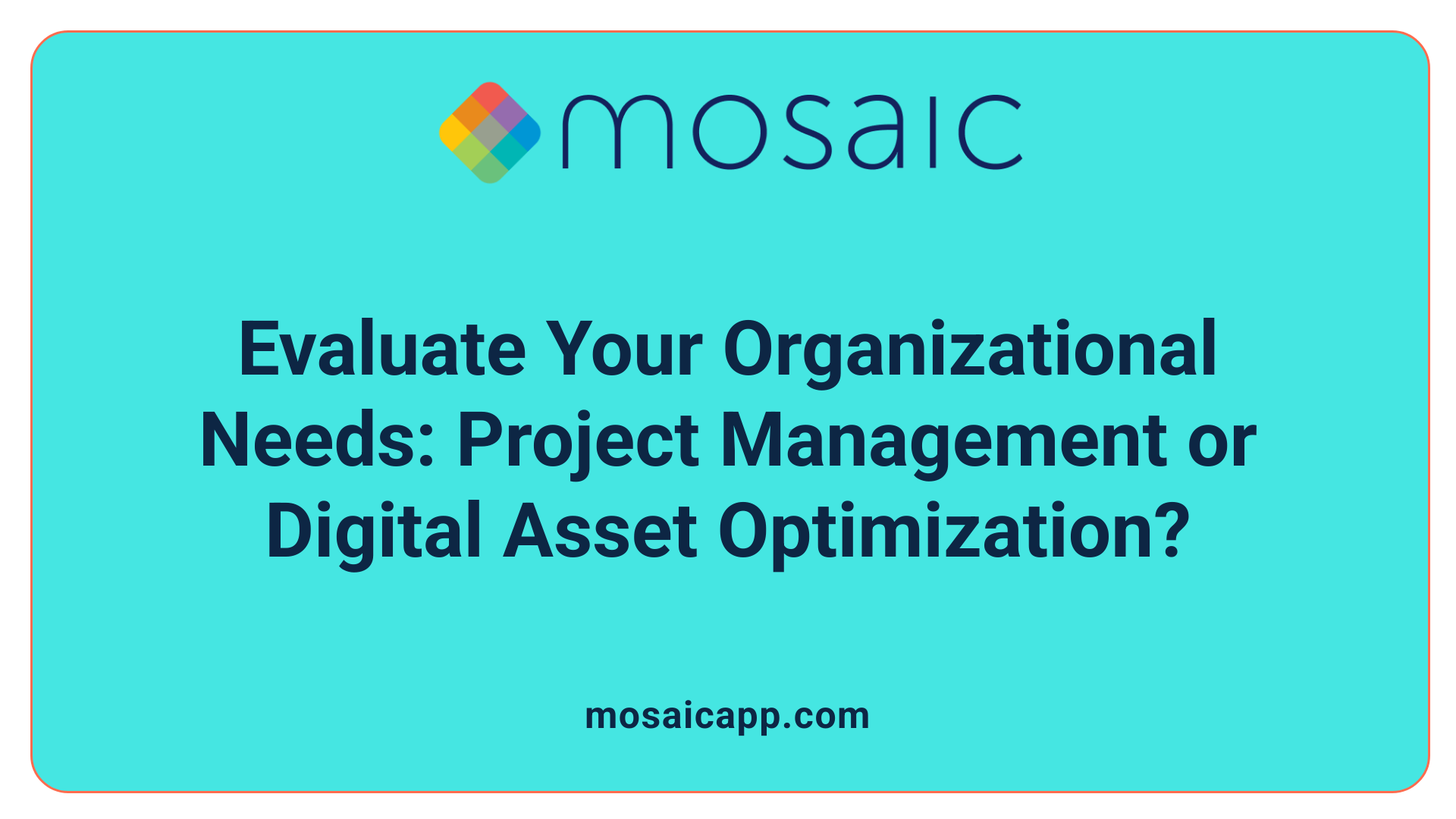Understanding the Core Differences in Evolving Resource Management Tools
In today's dynamic enterprise landscape, choosing the right resource management platform is crucial for operational success. Among the leading options, Smartsheet and Mosaic stand out for their unique capabilities tailored to diverse organizational needs. This article explores the nuanced differences between these tools to aid decision-makers in identifying the best fit for their enterprise resource management (ERM) strategies.
Key Functional Focus: Project Management vs. Digital Asset Optimization

What are the core functionalities of Smartsheet and Mosaic?
Smartsheet is primarily recognized for its comprehensive project management features. It offers tools for project scheduling, task management, and automation, all within a familiar spreadsheet-like interface. This platform facilitates real-time collaboration, enabling teams to track progress, manage dependencies, and automate routine processes to boost productivity.
On the other hand, Mosaic focuses on digital asset management. Its core strength lies in providing a centralized storage solution where organizations can organize, categorize, and tag digital resources like images, videos, and documents. This makes it easier for teams to access, share, and distribute assets efficiently, streamlining workflows that depend on managing extensive digital content.
Both platforms integrate with popular tools such as Microsoft Outlook, Okta, ServiceNow, Dropbox Business, and Zapier, enhancing their capabilities and fitting into existing workflows seamlessly.
What are the primary use cases for each platform?
Smartsheet is ideal for teams that need to oversee complex projects with multiple moving parts. Its project scheduling, task assignment, and automation features support activities from small teams to large enterprises managing detailed workflows and deadlines.
Mosaic is tailored for organizations aiming to optimize resource utilization through effective digital asset management. It is especially useful for marketing, media, and creative teams that handle large volumes of digital files requiring categorization, tagging, and easy retrieval.
The choice between these platforms often depends on whether the organization needs detailed project management tools or efficient digital asset control.
How do these platforms align with organizational objectives?
Smartsheet aligns well with organizational goals centered on enhancing project visibility, improving team collaboration, and automating repetitive tasks. Its versatility supports various project types, from simple task lists to complex, multi-department initiatives.
Mosaic complements objectives focused on resource efficiency and digital asset organization. Its capabilities help teams reduce content duplication, accelerate asset retrieval, and maintain consistency across digital resources.
Understanding these core functionalities and intended use cases helps organizations select the platform that best aligns with their strategic needs, whether for project execution excellence or resource management optimization.
| Aspect | Smartsheet | Mosaic | Additional Details |
|---|---|---|---|
| Main Focus | Project management, automation, collaboration | Digital asset management | Designed to improve workflows and team productivity |
| User Interface | Spreadsheet-like, intuitive | Centralized, category-based | Facilitates easy navigation and organization |
| Supported Platforms | Web, iPhone, Android | Web, Mac | Mobile support enhances flexibility |
| Pricing Model | Per-user fee | Per-feature basis | Cost structure influences scalability |
| Deployment | Cloud-hosted | Cloud-hosted | Both are accessible from anywhere |
| Ideal Use Cases | Project tracking, automations | Asset organization, distribution | Match to organizational needs |
| Ratings & Feedback | 3.9/5 on Trustpilot, 4.3/5 ease of use | Not specified here | User feedback guides usability and value perceptions |
Ultimately, the selection hinges on whether an organization needs robust project oversight or streamlined digital assets management, aligning technology choices with strategic goals.
Features and Functionalities: Enabling Business Operations

What are the main features and benefits of Smartsheet and Mosaic for enterprise resource planning?
Both Smartsheet and Mosaic are designed to support specific aspects of organizational management, but they serve different core functions.
Smartsheet is a versatile work management platform that emphasizes project scheduling, task management, and collaboration. Its familiar spreadsheet-like interface simplifies complex workflows, making it accessible for users. Smartsheet offers robust features such as Gantt charts, Kanban boards, automation rules, real-time updates, and extensive integrations with tools like Microsoft Outlook, Okta, ServiceNow, Dropbox Business, and Zapier. These capabilities facilitate seamless collaboration, increase transparency, and streamline project execution. Its automation and notification features help teams stay aligned, while reporting tools provide insights into project performance.
Mosaic, by contrast, specializes in digital asset management. It provides a centralized platform where organizations can organize, categorize, and distribute digital assets efficiently. Key features include asset tagging, centralized repositories, version control, and distribution workflows. Mosaic supports teams in marketing, branding, and creative assets management, helping to enhance operational efficiency in those areas.
While Smartsheet is designed for broad project planning, workflow automation, and resource management across multiple teams and projects, Mosaic's focus is on optimizing digital asset workflows. The primary benefit of Smartsheet is its ability to manage complex, multi-faceted projects with real-time collaboration and automation, making team coordination easier and more effective. Mosaic benefits organizations seeking a dedicated solution for digital asset handling, enabling quick retrieval, sharing, and versioning.
Pricing models differ, with Smartsheet using a per-user fee structure and Mosaic providing per-feature pricing. Deployment flexibility favors Smartsheet, which supports web, iPhone, and Android devices, while Mosaic offers web-based access and support for Mac environments.
In summary, the main features showcase Smartsheet's strength in comprehensive project tracking and automation, suitable for diverse team needs, whereas Mosaic excels in digital asset organization and distribution, essential for branding and media teams.
How do integration capabilities enhance organizational workflows?
Both Smartsheet and Mosaic provide integration options that expand their functionalities. Smartsheet connects with numerous third-party tools like Microsoft Outlook, ServiceNow, Dropbox, and Zapier, giving it an edge in automating workflows and bridging across platforms.
Mosaic also offers integration options tailored toward digital assets, facilitating smooth workflows between creative tools and asset repositories. Such integrations allow teams to streamline asset retrieval, tagging, and sharing processes.
| Feature | Smartsheet | Mosaic | Additional Details |
|---|---|---|---|
| Supported Devices | Web, iPhone, Android | Web-based, Mac support | Enhances accessibility and mobility |
| Pricing Model | Per-user fee | Per-feature pricing | Flexibility in licensing and scaling |
| Main Use Case | Project planning and automation | Digital asset management | Each platform caters to specific operational needs |
| Deployment Options | Cloud-based | Cloud-based | Both are easily accessible via internet |
What automation and real-time collaboration features do Smartsheet and Mosaic provide?
Smartsheet excels in automation, allowing teams to set rules for task updates, notifications, and recurring workflows. Its automation engine reduces manual inputs and enhances real-time collaboration.
Real-time updates are a standout feature for Smartsheet, enabling all team members to see project changes immediately, improving visibility and responsiveness.
Mosaic supports real-time asset updates and version control, which helps creative teams stay on the same page. While it may lack some automation features of Smartsheet, its focus on asset workflows ensures that digital content remains current and well-organized.
How does asset management capability differ between Smartsheet and Mosaic?
Smartsheet, while capable of supporting some document handling, is not primarily known for digital asset management.
Mosaic, on the other hand, is built specifically to handle large collections of digital assets. Its central feature set includes categorization, tagging, and easy distribution of digital content.
| Feature | Smartsheet | Mosaic | Use Case Examples |
|---|---|---|---|
| Asset Handling | Limited (mainly document sharing) | Centralized digital asset repository | Ideal for managing media, branding, and creative assets |
| Categorization and Tagging | Basic support | Advanced categorization and tagging | Helps users find and organize assets efficiently |
| Distribution Workflow | Manual sharing and integration | Automated distribution workflows | Streamlines publishing and sharing processes |
Considering their distinct niches, Smartsheet is more suited for broad project management needs, offering flexible automation and collaboration tools. Mosaic is tailored to organizations that require detailed digital asset organization and distribution, supporting creative workflows.
When choosing between Smartsheet and Mosaic, what should teams consider?
The decision largely depends on organizational priorities. Teams needing comprehensive project management with automation, extensive integrations, and real-time collaboration should lean toward Smartsheet.
Conversely, organizations focused on managing digital assets—like branding materials, media files, and content libraries—will find Mosaic more aligned with their needs.
Both platforms support cloud deployment, but their pricing structures and device compatibilities differ, influencing scalability and user access. Understanding these differences ensures a suitable fit for operational objectives.
| Aspect | Smartsheet | Mosaic | Additional Considerations |
|---|---|---|---|
| Primary Function | Project management and automation | Digital asset management | Align with organizational goals |
| Pricing Structure | Per-user fee | Per-feature pricing | Budget implications |
| Supported Devices | Web, iPhone, Android | Web, Mac | Accessibility and device preferences |
| Deployment | Cloud-hosted | Cloud-hosted | Ease of access and maintenance |
Ultimately, the choice hinges on whether the organization prioritizes comprehensive project workflows or specialized digital asset handling.
Approach to Resource Management: Platform Strategies

How do Smartsheet and Mosaic differ in their approach to enterprise resource management?
Smartsheet and Mosaic adopt distinct strategies to meet organizational needs for resources, reflecting their specialized focus areas.
Smartsheet is centered around project and work management, providing a flexible, spreadsheet-like platform that simplifies complex project planning. It excels in task management, real-time collaboration, and automation, making it suitable for teams that need comprehensive project tracking. Its integrations with tools like Microsoft Outlook, Zapier, and ServiceNow enhance seamless workflow automation and data sharing.
On the other hand, Mosaic specializes in digital asset management (DAM). Its primary goal is to streamline the organization, categorization, and distribution of digital content such as images, videos, and documents. This focus supports organizations needing efficient digital asset workflows, asset tagging, and centralized storage, enabling better resource allocation and reducing time spent searching or duplicating assets.
The differences extend to their pricing models and deployment options. Smartsheet charges per user and supports extensive cloud deployment options across web, iPhone, and Android devices. Mosaic offers a per-feature pricing structure, tailored more toward organizations managing numerous assets and requiring Mac or web-based environments.
| Software | Main Focus | User Interface | Deployment Environment | Pricing Model |
|---|---|---|---|---|
| Smartsheet | Project management, automation, collaboration | Spreadsheet-like, user-friendly | Web, iPhone, Android | Per-user fee |
| Mosaic | Digital asset management, resource organization | Asset-centric, centralized | Web-based, Mac-focused | Per-feature pricing |
Choosing between Smartsheet and Mosaic depends on whether an organization values comprehensive project oversight or needs advanced digital resource management. Smartsheet is ideal for teams aiming for versatile project tracking with extensive tool integrations. Mosaic suits organizations focused on managing digital assets and optimizing digital workflows. Ultimately, both tools align with organizational priorities—either broad project management or specialized digital resource handling.
Suitability and Best Use Cases for Your Organization

How to choose a platform based on organizational needs
Selecting the right resource management tool depends on your company's specific requirements. The decision primarily hinges on the nature of projects, team size, types of assets managed, and overall workflow. Understanding whether your focus is on task-oriented project management or digital asset organization can help steer the choice.
For organizations prioritizing flexible project scheduling, real-time collaboration, and automation, a platform like Smartsheet offers extensive features. It supports integrations with popular tools such as Microsoft Outlook, Zapier, and Dropbox Business, making it suitable for teams that need versatile project tracking and work management.
Conversely, if your organization’s main goal is managing, organizing, and distributing digital assets efficiently, Mosaic provides robust asset categorization and centralized storage. Its environment is optimized for digital asset management, making it ideal for teams that need to handle a large volume of digital content.
Scenarios where Smartsheet would excel
Smartsheet shines where project complexity calls for detailed planning, scheduling, and collaboration. Its spreadsheet-like interface allows users familiar with Excel to quickly adapt, and its automation capabilities streamline routine tasks. Companies conducting multiple projects, especially those requiring extensive team collaboration, would find Smartsheet advantageous.
Key features that make Smartsheet a good fit include:
- Project scheduling and milestone tracking
- Task assignment and monitoring
- Automated workflows for repetitive processes
- Real-time updates and seamless team collaboration
- Extensive integrations with third-party tools
Organizations engaged in product development, event planning, or any initiative requiring detailed task management will benefit most from using Smartsheet.
Situations where Mosaic would be most effective
Mosaic is designed for organizations that need to organize, store, and distribute digital assets efficiently. Its strengths lie in asset categorization, tagging, and centralized storage, making it ideal for marketing teams, media companies, or any organization managing large digital content libraries.
The platform enables teams to easily find and access digital assets, ensuring consistent branding and quick distribution. It supports collaboration in managing digital files, streamlining workflows related to asset approval and deployment.
Features that make Mosaic suitable include:
- Centralized digital asset repository
- Advanced categorization and tagging
- Efficient search and retrieval capabilities
- Integration with content distribution platforms
- Support for team collaboration around digital assets
Organizations that need to manage digital content in a structured and accessible way will find Mosaic a highly effective tool.
Comparing suitability: Enterprise resource management needs
| Criteria | Smartsheet | Mosaic | Additional Details |
|---|---|---|---|
| Focus of platform | Project and work management | Digital asset management | Smartsheet is geared towards planning and collaboration, while Mosaic focuses on digital assets |
| Use case examples | Complex project tracking, automation | Centralized digital asset management | Both are cloud-hosted, but Smartsheet supports mobile apps on iPhone and Android, and Mosaic supports Mac environments |
| Pricing model | Per-user fee | Per-feature pricing | Flexibility in pricing varies; organizations should consider their budget and needs |
| Device support | Web, iPhone, Android | Web-based, Mac support | Compatibility depends on device preferences and existing infrastructure |
| Overall suitability | Best for project-heavy teams | Best for content and digital asset teams | The choice depends on whether organizational focus is planning or assets |
Final considerations
Ultimately, the decision hinges on what your organization needs most. For companies requiring a versatile platform for project planning, scheduling, and team collaboration, Smartsheet is often the better fit. On the other hand, organizations focused on managing a broad array of digital assets will find Mosaic’s features more aligned with their goals.
Both platforms support cloud deployment and offer different support and training options, ensuring that organizations can adopt them smoothly. By evaluating the focus of your projects and asset needs, your team can select the platform that boosts productivity and streamlines operations most effectively.
Decision-Making Considerations: Choosing the Right Platform

What should organizations consider when choosing between Smartsheet and Mosaic for enterprise resource management?
When organizations are evaluating whether to adopt Smartsheet or Mosaic for their enterprise resource management (ERM), there are several important factors to consider. These factors include cost, features, deployment options, support resources, and integration capabilities.
Cost and Pricing Models
Smartsheet operates on a per-user fee structure, which means that organizations pay based on the number of users accessing the platform. It starts at $12.00 per month per user, with additional pricing options available upon request for larger teams or advanced features. Mosaic, on the other hand, uses a per-feature billing approach, allowing organizations to select specific functionalities they need and pay accordingly. This difference in pricing models can significantly impact budget planning, especially for large teams or organizations with specific needs.
Features and Functionalities
Smartsheet is celebrated for its versatility and user-friendly interface that resembles spreadsheets, making complex project management and automation straightforward. It supports real-time updates, a wide array of integrations such as Microsoft Outlook, Okta, ServiceNow, Dropbox Business, and Zapier, along with project scheduling, task management, and collaboration tools. Its dashboard features enable teams to visualize work progress effectively.
Mosaic specializes in digital asset management, offering centralized storage, categorization, and tagging of digital resources. It is designed to improve digital media workflows, making asset organization and distribution more efficient. While it also supports resource planning and team collaboration, its primary strength lies in managing digital content.
Deployment Options and User Support
Both platforms are cloud-hosted, providing ease of access and scalability. Smartsheet supports web, iPhone, and Android devices, catering to a broad range of mobile users. Mosaic supports web and Mac environments, ideal for organizations primarily using Apple hardware.
Support and training resources are available for both tools, with options for onboarding, tutorials, and customer support. Smartsheet’s ratings indicate a solid user experience with an overall ease of use scored at 4.3 out of 5 and value for money at 4.4 out of 5.
Integration and Scalability
Both tools excel in integration with third-party applications, a crucial aspect for organizations aiming to streamline workflows across multiple systems. Smartsheet’s extensive integrations and automation capabilities support large teams and complex projects. Mosaic also offers integration options but is more tailored to digital asset workflows.
How do these differences influence the decision?
Organizations primarily focused on comprehensive project tracking, task management, and collaborative automation might find Smartsheet more suitable. Its wide array of project management features and familiar spreadsheet interface make it an excellent choice for versatile work environments.
Conversely, organizations that prioritize digital asset management, media resource organization, and efficient team collaboration around digital content will benefit from Mosaic’s specialized features.
Choosing between these platforms ultimately depends on assessing specific organizational needs:
| Aspect | Smartsheet | Mosaic | Additional Notes |
|---|---|---|---|
| Primary Use | Project management, automation | Digital asset management | Focus determines the best fit |
| Pricing Model | Per-user | Per-feature | Budget considerations |
| Device Compatibility | Web, iOS, Android | Web, Mac | Accessibility requirements |
| Support & Training | Extensive, rated well | Available, niche focus | User experience implications |
| Integration Support | Extensive | Focused on digital assets | Compatibility with existing tools |
In conclusion, the decision hinges on whether an organization requires extensive project tracking and workflow automation (favoring Smartsheet) or advanced digital asset management and media workflows (favoring Mosaic). Both tools are capable and cloud-based, allowing flexibility in deployment and operation.
Emerging Trends and Strategic Considerations in ERM Tools
Impact of digital transformation on resource management
The ongoing digital transformation in organizations has significantly reshaped how enterprises approach resource management. Cloud-based tools like Smartsheet and Mosaic exemplify this shift, providing real-time collaboration, centralized data storage, and scalability that traditional systems lack. As businesses increasingly move operations online, these tools facilitate seamless integration with existing digital workflows, enabling teams to access necessary information anytime and from any device.
Organizations embracing digital transformation benefit from improved agility, faster decision-making, and enhanced transparency. Smartsheet, for example, offers a spreadsheet-like interface familiar to many users, making it easier to adopt without extensive training. Meanwhile, Mosaic’s focus on digital asset management ensures that digital materials are systematically organized, improving workflow efficiency.
Role of automation and AI in ERM
Automation and artificial intelligence (AI) are playing a growing role in Enterprise Resource Management (ERM) tools. Smartsheet supports automation features that streamline routine tasks, such as updating schedules or sending notifications, saving time and reducing errors. With integrations like Zapier, users can further automate workflows across multiple platforms.
AI capabilities are also expanding within ERM systems. These features can predict project risks, optimize resource allocation, and provide insights for better strategic planning. Mosaic, with its advanced asset management, could leverage AI for tagging, categorizing assets automatically, and providing recommendations for asset utilization.
Future outlook for Smartsheet and Mosaic in enterprise environments
Looking ahead, the trajectory of Smartsheet and Mosaic in enterprise environments is shaped by their ability to evolve technologically and meet growing organizational demands. Smartsheet is likely to continue enhancing its automation features and integrations, aiming to become an even more comprehensive project management platform. Its widespread user base and high ease-of-use rating position it well for further growth.
On the other hand, Mosaic’s focus on digital asset management positions it as a critical tool for organizations that deal heavily with digital content, such as media companies and marketing teams. Future developments may include enhanced AI-driven asset categorization and improved collaboration features tailored for creative and digital teams.
Both platforms are expected to incorporate more sophisticated analytics, increased support for mobile and remote access, and expanded deployment options. As enterprise resource management becomes more integral to business success, these tools will need to adapt by offering more customization, stronger security, and deeper integrations.
Comparing trends and future potential
The table below summarizes the current state and future outlook for Smartsheet and Mosaic, emphasizing their focus areas and technological advancements:
| Aspect | Smartsheet | Mosaic | Future Potential |
|---|---|---|---|
| Core Functionality | Project scheduling, task management, automation | Digital asset management, resource allocation | Both will incorporate AI for predictive analytics and automation |
| Deployment | Cloud-based, supporting multiple devices | Cloud-based, primarily Mac and web | Increased remote and mobile capabilities |
| Integration & Automation | Extensive, including Outlook, Dropbox, Zapier | Focused on digital assets, tagging, and distribution | Expanded AI and machine learning features |
| User Adoption & Ease of Use | 4.3/5 rating, user-friendly | Focus on digital task efficiency | Focus on AI-enhanced user experience and customization |
| Pricing Models | Per-user fee, scalable | Per-feature pricing | Greater flexibility and tailored solutions |
| Strategic Focus | Versatile project management | Digital asset optimize and digital content workflows | Broader AI integration, analytics, and mobility |
As organizations continue to adapt to digital shifts, ERM tools like Smartsheet and Mosaic will remain vital. Their ability to innovate and integrate emerging technologies will determine their relevance and effectiveness in supporting enterprise goals in the future.
Making an Informed Choice for Enterprise Success
Ultimately, the decision between Smartsheet and Mosaic hinges on organizational priorities—whether comprehensive project management or specialized digital asset handling. Smartsheet's versatility in project planning and automation makes it an excellent choice for teams seeking broad operational control, whereas Mosaic's focus on digital assets aligns with organizations aiming for optimized resource use in media and branding. Carefully assessing specific needs, scalability, support, and budget considerations will facilitate an informed selection, setting the stage for operational efficiency and strategic growth in enterprise resource management.
References
- Smartsheet vs Mosaic - 2025 Comparison
- Compare Smartsheet vs Mosaic 2025
- Smartsheet vs Mosaic - 2025 Comparison
- Compare Smartsheet vs Mosaic 2025
- Compare Smartsheet vs Mosaic 2025
- Smartsheet vs Mosaic - 2025 Comparison
- Smartsheet vs Mosaic - 2025 Comparison
- Compare Smartsheet vs Mosaic 2025
- Compare Smartsheet vs Mosaic 2025


